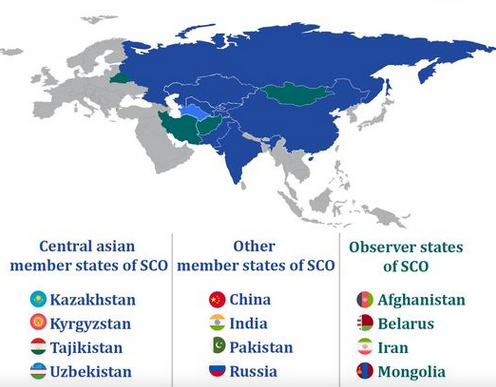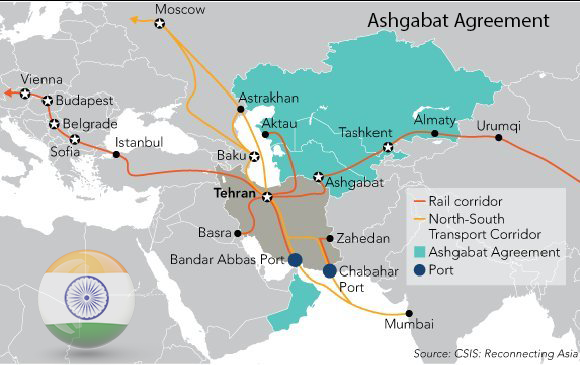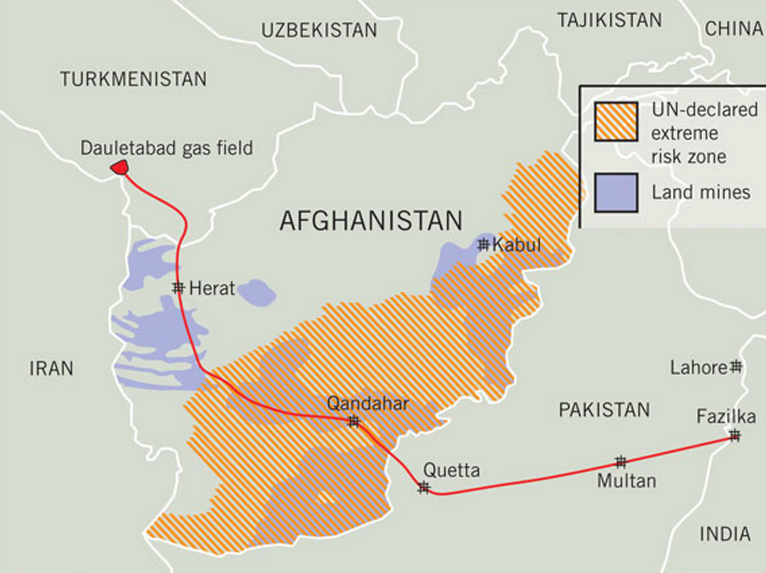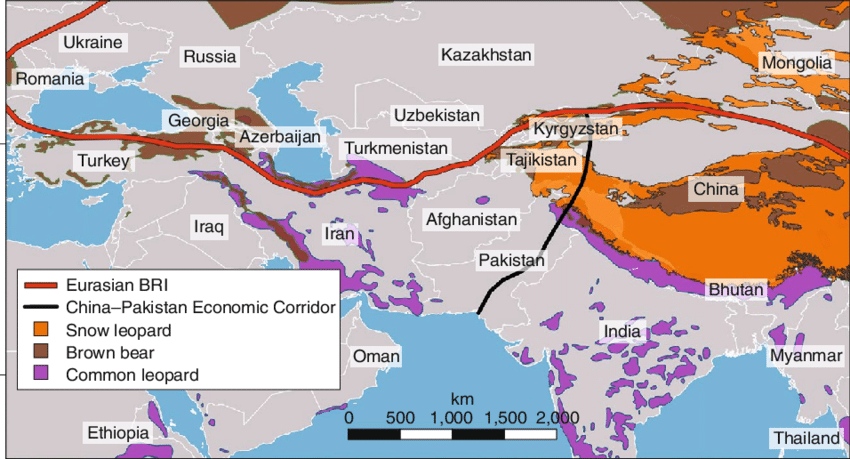India-Central Asia Relations – Significance, Challenges, Way Ahead
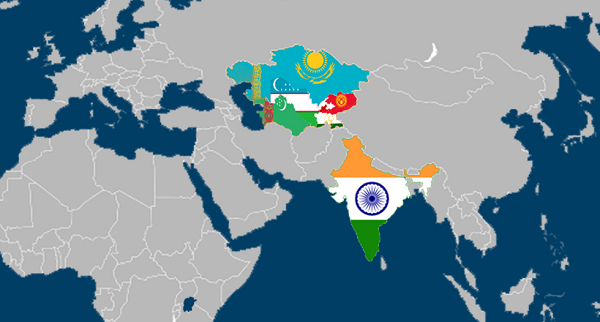
Despite being economically and politically weak, Central Asia is playing an important role in international politics due to its geostrategic location and abundant natural resources. Many countries like the US, Russia and China are competing to make their presence in the region. India’s interests have also increased, mostly aimed at reducing Chinese influence in the region. Yet, India’s relations with the Central Asian countries are hampered by geography, economic constraints, security concerns and red-tapism. Addressing these issues would enable India to gain access to one of the most strategically significant regions in the world.
This topic of “India-Central Asia Relations – Significance, Challenges, Way Ahead” is important from the perspective of the UPSC IAS Examination, which falls under General Studies Portion.
Where is Central Asia?
- Central Asia is a region that stretches from the Caspian Sea in the west to China and Mongolia in the east, from Afghanistan and Iran in the south to Russia in the north.
- This region consists of Kazakhstan, Kyrgyzstan, Tajikistan, Turkmenistan and Uzbekistan.
- All of these nations became independent in 1991 after the collapse of the USSR.
What is the genesis of India-Central Asia relations?
- India’s relations with the Central Asian countries can be traced back to the ancient Silk Road, along which people, goods and ideas flowed.
- During the period of the Kushan Empire, which spanned across the territories of modern Central Asia and India, the people-to-people contact, cultural and economic ties were flourishing.
- The dissolution of the ancient Silk Road, the invasion of Central Asia by Russia and China and the Anglo-Russian rivalry has limited the exchanges between India and Central Asia.
- Immediately after independence, India maintained limited ties with Central Asian countries because of the former’s excessive focus on the immediate neighbourhood, major powers in the international arena and other Afro-Asian countries.
- This may be because of the lack of shared boundaries.
- Following the USSR dissolution, the five Central Asian countries gained independence and India started to improve ties with them.
- India was the only non-communist country with a diplomatic presence in the region.
- It was also one of the first to accord diplomatic recognition to the newly independent countries.
- Immediately after the formation of the Central Asian states, New Delhi signed agreements focusing on expanding Indian trade, investment and developmental assistance.
- At present, Central Asia is considered to be a part of India’s extended neighbourhood.
What are India’s strategic interests in Central Asia?
- Central Asia sits at the heart of Eurasia, making it strategically vital for countries like the US, China, Russia, Europe and India.
- This is because it serves as a pivot for geopolitical transformations within the international arena.
- Many countries are currently competing to increase influence and power over the region.
- Through this region, countries like India and China can expand their markets throughout Eurasia.
- Apart from its geostrategic position, Central Asia has been rich with natural resources – Turkmenistan with gas, Kazakhstan with gas and uranium, Tajikistan and Kyrgyzstan with hydropower.
- With a population of 33 million in the 1990s, this region is potentially a large market.
What are the areas of cooperation?
Military:
- Initial interactions emphasised on common threats like religious extremism, ethnic chauvinism, terrorism, narcotic-funded violence and crime.
- Tajikistan civil war between 1992 and 1997 was backed by Pakistan-backed Afghan Mujahedeen.
- This forced India to extend outreach to Central Asia due to its fear of Pakistan gaining advantage out of the civil strife.
- Tajikistan, as a result, became India’s bridgehead in the region during this period.
- Subsequently, Tajikistan became the recipient of the long-term Indian military training.
- In 2002, India and Tajikistan signed bilateral defence agreement, under which India refurbished Ayni, a disused Soviet airbase.
- India’s military relations with other Central Asian countries have been significant, but far more limited.
- The overall military cooperation with the region is mostly limited to military education, infrastructure and training.
- Later, India conducted its first-ever joint military exercise with Kyrgyzstan in 2011.
- During PM Modi’s visit to all five Central Asian countries in 2015, India has enhanced the institutional basis for its defence cooperation at bilateral levels.
- The visit resulted in the signing of MoUs and agreements related to defence and military technical cooperation with Kazakhstan, Kyrgyzstan and Turkmenistan.
- India and Kazakhstan held the first-ever joint military exercise in 2016. Held annually since then, this exercise was renamed as KAZIND in 2018.
- This exercise focuses on countering insurgency and terrorism in an urban and rural environment.
- In 2018, India and Uzbekistan agreed to expand cooperation in the areas of counterterrorism with the joint military exercise, military education and military medicine.
Energy:
- Despite the abundance of hydrocarbons in the region, the only significant progress made in the energy sector has been civil nuclear cooperation.
- In 2008, Kazakhstan supported India in obtaining an exemption to allow civil nuclear cooperation with the Nuclear Suppliers Group (NSG) countries.
- Later, India and Kazakhstan signed a civil nuclear deal for the supply of 2,100 tonnes of uranium to India until 2014.
- After the expiration of the 2014 deal, both countries later signed an agreement for the purchase of 5,000 tonnes of uranium until the end of 2019.
- They are currently planning to increase uranium supplies to India to 7,500 to 10,000 tonnes.
- India signed a uranium supply agreement with Uzbekistan as well.
Trade:
- India trade is largest with Kazakhstan, with a turnover of USD 851.91 million in 2018-19.
- This accounts for just 0.10% of India’s total trade.
- The trade with Uzbekistan is the second-highest, with $328.14 million. This accounted for just 0.04% of India’s total trade.
- India and Uzbekistan have signed several trade agreements. India is among the 45 countries to which Uzbekistan provides the most favoured nation (MFN) status.
- India imports mainly include precious and semi-precious stones, chemicals, iron and steel, machinery, mineral oils copper goods, plastic goods, wool and leather.
- Exports include coffee, tea, spices, apparel and clothing, pharmaceutical products and electrical and mechanical equipment.
What are the measures taken to improve India’s ties with Central Asia?
International North-South Transport Corridor (INSTC):
- INSTC is a 7,200 km-long multimodal transportation network that links the Indian Ocean to the Caspian Sea via the Persian Gulf onwards into Russia and Northern Europe.
- It was launched as a joint initiative by India, Iran and Russia in 2000.
- The corridor has now expanded to include 11 more members – Azerbaijan, Armenia, Kazakhstan, Kyrgyzstan, Tajikistan, Turkey, Ukraine, Syria, Belarus, Oman and Bulgaria (observer).
- The INSTC is the most salient feature of India’s Connect Central Asia Policy as acts as a gateway for India’s connection with the resource-rich nations of Central Asia and Eurasia.
- INSTC provides following advantages for India:
- It provides westward connectivity for India, which is disrupted by tensions with Pakistan. It allows India to bypass and reduce dependence on Pakistan for connectivity with Central Asia, Afghanistan and Eurasia.
- It enables India to balance China’s growing presence in the region
- Ties with Russia, Iran and Central Asia can be improved.
- INSTC is to be 40% shorter and 30% cheaper than the traditional route via the Suez Canal
- The INSTC’s progress is currently hindered by diplomatic tensions (India-Iran, Armenia-Azerbaijan etc.), security concerns, technical issues and fund constraints.
Connect Central Asia Policy:
- Unveiled in 2012, this policy seeks to improve India’s political and economic relations with Central Asia.
- The policy is based on 4Cs – Commerce, Connectivity, Consular and Community.
- Its key elements involve political cooperation, economic cooperation, strategic interests, regional connectivity, IT, education, people-to-people contact and health.
- The policy was reinforced in 2015 after PM Modi became the first Indian head of state to visit all five Central Asian countries.
- Since then, progress has been made in security, energy and connectivity
- The renewed focus can be attributed to China’s BRI and external security threats.
- The significance of this policy include the following:
- The realisation of the potential of strategic and economic interests provided by Central Asia’s location and resources
- India’s overseas airbase is located in Farkhor, Tajikistan
- India’s key sectors like IT, tourism and pharmaceuticals can be enhanced with the economic development of Central Asia
- ‘Golden Crescent’ of opium production (Iran-Pakistan-Afghanistan) is near Central Asia, which is also a victim of terrorism, illegal arms trade.
- Central Asian countries play a key role in promoting India’s interests in the international arena like its bid to become a permanent member of the UNSC.
Shanghai Cooperation Organisation:
- Twelve years after becoming an observer, India gained permanent membership in the Shanghai Cooperation Organisation in 2017.
- The change of status from an observer to a full member marks an important shift in India’s approach to the region as a whole.
- With India and Pakistan becoming permanent members, the influence of Russia and China is reduced.
- The SCO now represents around 42% of the global population and 20% of the global GDP.
- It enables India to maintain connectivity with Central Asia and the world in the areas of common economic and security concerns.
- India will be hosting a summit of the council of heads of government of SCO on November 30 this year with the focus on contributing to trade and economic agenda of the grouping.
TIR Convention:
- India ratified the International Road Transport (TIR) Convention.
- TIR Convention is a multilateral international transit treaty, which is also known as Customs Convention on International Transport of Goods under the cover of TIR Carnets.
- It functions under the auspices of the UN Economic Commission for Europe (UNECE).
- It will help India access transnational multimodal connectivity and promote trade with the eastern and western neighbourhood.
- It will enable India to move cargo along the International North-South Transport Corridor (INSTC) via Chabahar port.
Ashgabat Agreement:
- India ratified Agreement on the Establishment of an International Transport and Transit Corridor, which is also known as Ashgabat Agreement in 2018.
- It is an agreement between Iran, Oman, Turkmenistan and Uzbekistan signed in 2011.
- In 2016, Pakistan and Kazakhstan joined this grouping.
- The agreement would enable the transportation of goods to Central Asia and the Persian Gulf.
- The accession to this agreement diversifies India’s connectivity options with Central Asia.
TAPI pipeline:
- The Asian Development Bank-backed Turkmenistan-Afghanistan-Pakistan-India (TAPI) pipeline will be a 1,814 km trans-country natural gas pipeline that endeavours to bring 33 billion cubic meters of Turkmen gas to Pakistan and India via Afghanistan for 30 years.
- It is also known as the Peace Pipeline and Trans-Afghan Pipeline,
- The work on the $10 billion pipeline began in 2015.
- The pipeline was expected to begin operations in 2020, but its launch has been repeatedly postponed because of instability in Afghanistan and distrust between India and Pakistan.
What are the challenges?
Trade and investment:
- Central Asian republics may not be key export markets or investment destinations for Indian companies as of now.
- Also, there are complaints regarding arbitrary seizures of goods and frequent changes in customs procedures without prior notifications.
- Excessive documentation and lack of proper protocols make import process difficult, costly and time-consuming.
Defence:
- Security cooperation has is hindered by the lack of shared borders and connectivity.
- India doesn’t even have a direct sea route to this region due to the landlocked nature of these countries.
- For India to reach Central Asia, the shortest route is via Afghanistan and Pakistan.
- Political instability in Afghanistan and Pakistan’s hostile relations with India and close ties with China makes overland connectivity with Central Asia problematic.
Energy:
- The growth of energy demand has forced India to diversify sources beyond the volatile Gulf.
- Central Asia is one of these sources.
- However, oil and gas diplomacy was hampered by the lack of connectivity and infrastructure.
Deteriorating India-Iran ties:
- Due to delays and US sanctions, India has been cut out of Chabahar-Zahedan line project and an Iranian gas field project, Farzad B.
- This has deteriorated bilateral ties with Iran.
- This has minimal impact, as regardless of who builds the railway line, Indian trade will make use of it to connect with Afghanistan and Central Asia.
- However, India has lost Iran’s trust, making it difficult to promote future joint infrastructure projects, which is vital for India-Central Asia connectivity.
- The usual seaport for Indian businesses trading with Central Asia has been Bandar Abbas in Iran.
- However, its use has been restricted due to the US sanctions on Iran, resulting in lower trade volumes.
- Despite instructions from the RBI, Indian exporters were not issued BRC (Bank Realisation Certificate) by Indian banks for the transit of goods via Iran for the destination to a third country even though the exporter already received payment in foreign currency.
- Therefore, trade volumes have been significantly affected by these unilateral sanctions.
China:
- China has made huge inroads into Central Asia through its BRI, large-scale investments and infrastructure projects.
- The BRI investments and loans to Central Asian countries have increased trade between the regions exponentially.
- However, the Central Asian Republics receive a very little benefit because of China’s import of raw materials and flooding of over-produced goods.
- These countries are suffering from debts due to these factors, creating very little potential for Indian investors and exporters.
What are the opportunities present in Central Asia for India?
Despite the progress, the full potential of the bilateral trade with Central Asia is not yet realised by India. Central Asia-India trade partnership is currently provided with unique opportunities because of the changing global economic environment. Several areas that present attractive opportunities for Indian investment and cooperation in this region include hydropower sector, mining and metallurgical industries, construction industry, entrepreneurship development, infrastructure, agro-industrial sector, information technology (IT), textile industry, leather industry, tourism, higher education, food processing, etc.
Agriculture:
- Central Asia has huge cultivable areas lying barren and unproductive.
- Uzbekistan alone offers an enormous opportunity for the cultivation of pulses.
- Large quantities of pulses including kidney beans from the region are brought over by Turkish firms and are re-exported to India.
- Spices trade and horticulture also provide opportunities for improving trade relations.
Construction:
- The construction sector in Central Asia is experiencing significant growth.
- Kazakhstan, in particular, has created a competitive market for investments in this sector.
- Due to the economic growth, several areas within the region are becoming attractive for the construction business in residential, non-residential and civil engineering segments of the market.
- These are significant opportunities for Indian companies dealing with financial services, construction, engineering and management.
- Additional focus can also be given to connectivity projects.
Textile industry:
- Though Central Asia’s traditional sericulture and cotton textile industries have declined over the past years, they are becoming a major economic source for the rural population in Uzbekistan and Kyrgyzstan.
- After India and China, Uzbekistan is the third-largest producer of silk to the global market.
- Cooperation in silk manufacturing is one of the many opportunities present in Central Asia.
- It can ensure rural growth, poverty alleviation and job opportunities for both India and Central Asia
- High-quality cotton production from all Central Asian countries can be a boon for Indian textile industries.
- Both sides can consider setting up of integrated textile plants in the region to manufacture good quality cotton and blended fabrics.
- This initiative can be a profitable venture due to Central Asia’s location near the lucrative European markets.
Tea industry:
- Despite Indian tea’s popularity, the exports have dropped since 2012 because of competition from Kenya and Sri Lanka.
- This can be addressed by setting up tea blending and packing factories in Central Asia to offer high-quality Indian teas to the region.
Anti-China sentiments:
- Since 1991, Beijing has expanded its commercial footprint in Central Asian countries.
- While investing to buy hydrocarbons, China is flooding the markets with finished goods without any regard for the region’s indigenous industries and factories.
- Most of the investments from China come with Chinese workers and security personnel.
- The presence of Chinese security personnel has increased manifold after the 2016 bombing of the Chinese embassy in Kyrgyzstan
- China’s BRI investments lack transparency and are accused of bringing in debt traps for countries.
- Less resource-rich countries like Kyrgyzstan and Tajikistan already owe China an estimated USD 4 billion and USD 1.38 billion in loans respectively.
- These countries are forced to transfer greater control over the assets to China if they defaulted in the repayment of the loans
- This led to Beijing gaining the geostrategic advantage at the cost of food security of these countries
- Thus, the Central Asian countries are looking towards countries like India to balance China’s growing influence.
- While China’s increased engagement in the region has provided economic opportunities for these countries, it has provoked mistrust among its civil societies.
- This provides an opportunity for India to increase investments in the region.
What the steps India need to take to improve ties and presence in Central Asia?
Connectivity:
- To augment the full potential of Central Asian relations, India can improve its deteriorated ties with Iran, as it serves as a critical link between India and Central Asia.
- India can regain Tehran’s trust with its investments in Chabahar Free Trade Zone. It can also promote Chabahar as a transit hub for trade with Central Asia.
- The use of Chabahar port by Indian businesses can be promoted as it is currently not under US sanctions and is closer to India’s west coast.
- India could also encourage other friendly nations to use Chabahar port for their trade with Afghanistan.
- One such country is Australia, which is using Gwadar port for exporting goods to Afghanistan.
- Improvement of logistical services and infrastructure of Chabahar port can improve its attractiveness among businesses.
- Digital connectivity can be strengthened via cooperation in the IT sector. Promotion of software exports using Uzbekistan as a hub would help India access the Russian market.
- Since there is no direct connectivity to bring natural gas from Central Asia to India, New Delhi can invest in the setting up of petrochemical industries in the region.
Air Routes:
- While incentivising the use of Chabahar port, India must simultaneously develop the air route by promoting easy flight connectivity.
- India can create an Air Corridor, like the one it has with Afghanistan.
- This would promote India-Central Asia trade and enhance India’s outreach to the region.
- The simultaneous promotion of Air Corridor and Chabahar port would reduce dependence on one mode/route and prevent the creation of potential chokepoints.
Trade and investment:
- The full potential of trade and investments between India and Central Asia is not realised because of the lack of information and awareness about the economic and commercial opportunities available in the region.
- The necessary information and awareness can be disseminated via trade shows, fairs, exhibitions etc.
- Despite being unattractive for export and investment promotion, these countries are rapidly being linked to the global market for production and supply of raw materials and services.
- They are also getting integrated into the East-West Trans-Eurasian transit economic corridor.
- India can take efforts to expeditiously finalise the Free Trade Agreement with Eurasian Economic Union (EAEU), which includes Armenia, Belarus, Kazakhstan, Kyrgyzstan and Russia.
- This will enable India to have direct access to the region’s huge hydrocarbon resources.
- The proposed Preferential/Free Trade Agreement between INSTC members should be finalised.
- Until Free Trade Agreement is signed, India can consider extending trade privileges and preferential trade partner status to Central Asian countries on a mutually beneficial basis.
- Such arrangements would reduce the region’s excessive dependence on Chinese goods and services.
- Several trade barriers that are currently existing in India can be removed in favour of Central Asian countries.
- Heritage tourism based on historical and cultural linkages between India and Central Asia can be promoted.
- A joint tourism council can implement this aspect.
- Medical tourism has immense potential due to India’s affordable and quality medical services.
- More awareness of these services can be promoted in Central Asia.
- Soft diplomacy can also be used to promote tourism.
- Media outreach and collaborations and visa-free regime can play a significant role in promoting people-to-people contacts.
History and Archaeology:
- Cooperation between national museums can further improve India-Central Asia ties.
- This can help in factual countering of one-sided Silk Road narrative promoted by China.
- Joint archaeological research between India and Central Asia can help overcome historical prejudices.
- Many students from Central Asia are already coming to India for higher studies due to India’s ability to provide education at a marginal cost when compared to European and American universities.
- Indian students are also visiting Central Asia for research purposes.
- India can leverage this potential to improve the attractiveness of the educational sector.
- Educational links can be expanded by setting up more Indian educational institutes in Central Asia
- Scholar exchange programmes and expertise sharing can be promoted.
Defence Cooperation:
- Joint manufacturing in defence sector can be promoted.
- The India-Uzbekistan military medicine agreement can be expanded to other Central Asian republics.
- Joint training can be promoted
- India-Central Asia Defence Expo can be organised.
Security Cooperation:
- Regional security issues in Central Asia could have a potential impact on India.
- Increasing Islamic radicalisation has become a major issue for these countries in this region as thousands of Central Asians migrated to join the Syrian War and Islamic State.
- India too faces similar problems.
- Central Asia and India can cooperate on deradicalisation of youth and countering terrorism, narcotics and cyber threats.
- Cooperation on Afghanistan’s stabilisation is vital given the security threats posed by Taliban and other extremist factions within the country.
- India’s expertise in dealing with the crisis related to climate change and disasters could be promoted in Central Asia in the form of mock drills and renewable energy technologies.
Political relations:
- The five Central Asian countries differ significantly in socio-economic terms.
- India’s broad policy framework for the region should be such that its relations with each of these countries could be nurtured separately.
- While ensuring this, it is equally important to work towards greater harmonisation of policies.
- This requires high-level working groups and adequate integration of policies and laws.
- Smooth transition to harmonised policies and laws must be ensured without abruptly changing the local laws.
Conclusion:
India-Central Asia ties have the potential to raise India’s stature in the international system. India’s increased presence in the region would ensure stability, security, economic growth and development. This, in turn, would enable India to realise its energy needs and address security concerns. Thus, giving equal importance to India’s extended neighbourhood is vital for realising its aspiration of becoming a major power.
Practice question for mains:
Iran plays a critical role in India’s interests in Central Asia. Elucidate. (250 words)
https://carnegieindia.org/2019/12/01/realizing-india-s-strategic-interests-in-central-asia-pub-80576
https://www.vifindia.org/sites/default/files/VIF-Roundtable-on-India-Central-Asia-Relations.pdf
https://www.orfonline.org/expert-speak/india-in-pivotal-geographies-central-asia-54525/
https://idsa.in/policybrief/indias-economic-opportunities-in-central-asia-pstobdan-170918
https://thediplomat.com/2020/01/more-tapi-delays-this-time-in-afghanistan/
https://eurasiantimes.com/turkmenistan-afghanistan-ink-deal-on-joint-projects/
https://www.icwa.in/show_content.php?lang=1&level=1&ls_id=5330&lid=3755



